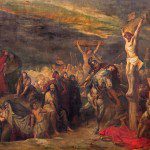We’ve spent the last few posts deconstructing aspects of the Penal Substitution theory of the atonement that so many of us grew up with (series archive, here). Today we turn away from the necessary deconstruction and begin reformulating a healthy view of the atonement.
When I was doing my graduate work at Gordon-Conwell before going to Fuller for my doctorate, I had the opportunity to study atonement theology– an encounter for which I will always be grateful. I entered those studies holding a rigid Penal Substitution view, as I didn’t know there were other options, and certainly hadn’t explored them. However, in time I found that using penal metaphors exclusively or rigidly certainly didn’t make sense– for all the reasons I have outlined in this series thus far.
When it came time to rebuild my atonement theology, I decided to clear the table of everything else that had been put on it, and begin rebuilding by returning to what Jesus said about it.
When struggling with theology, there’s no better move than returning to what Jesus said about it.
When I examined how Jesus described the atonement, I stumbled upon a single word that he used– a word that, for me, changed my entire view and approach to it.
The word? Ransom. (λύτρον)
In Matthew 20:28 and Mark 10:45 we see Jesus describe his own coming work on the cross, which he describes as giving his life “as a ransom for many.”
Personally, I think this is hugely significant. Had Jesus come to be offered as a sacrifice to God, I would have imagined when he talked about the atonement, he would have said as much. However, that’s not the concept he expressed or the words that he used– he specifically described what was happening as the paying of a ransom.
Just think about the word and concept for a moment.
Now, let me ask you a big question: When a child is kidnapped and a ransom is demanded, who is the one who demands a ransom?
In the Penal Substitution view of the atonement, the death of Jesus is a payment to God— but Jesus called it a ransom, and ransoms aren’t paid to the parents of the kidnapped!
Ransoms are paid by the parents of the kidnapped.
Ransoms are not demanded by those who are good, but by those who are evil. As we have talked about the death of Christ, and the idea of blood sacrifice, many have rightly objected to the idea that God would demand and need such a thing– it seems vile and abusive to kill an innocent human being. It’s an affront to our God-given sense of morality and justice, and rightly so.
So here’s where we’re at: We’ve demonstrated the idea of God being the causing agent who demanded the death of his own son as a blood sacrifice makes little sense. But we must still contend with Jesus’s own words that he was willingly going to the cross as a payment to ransom us. We also must contend with the idea that Jesus died as a net result of humanity’s sin, that he somehow stood in our place in that moment, and that the result was our freedom.
And that invites the question: Who would be so evil that they would demand or enjoy Jesus– one who was not under the penalty of sin and the least deserving of anyone who has ever lived– be hoisted up on a cross and brutally slain?
And that question brings us to who I think is the missing character in most atonement theology: the Devil himself.
When we consider the meaning of ransom, and when we take a new look at the character who often gets left out of atonement discussions, to me the picture begins to make more sense. The cross was a payment, a ransom– but not one demanded by God, it was a ransom paid by God.
I’d invite you to consider the first mention of the atonement, which actually occurs at the beginning of God’s story. As soon as sin and death enter the world, what does God tell the serpent in the garden?
In Genesis 3:15 God makes a reference to what is to come and says, “You will bruise his heel, but he will crush your head.”
Did you catch that? You will bruise his heel. This, I believe, is a reference to the death of Christ– and this makes Satan the causing agent of the cross.
Now, fast forward to the New Testament after the death and resurrection of Jesus. How do authors describe what happened on the cross? Well, John seems to continue this theme of Satan being a chief player in it all. In fact, in 1 John 3:8 he actually says that the ultimate reason Jesus came was to “defeat the works of the Devil.”
Too often atonement theology is truncated and reduced in ways that are not helpful. Part of a solution is viewing the cross from 50,000 feet instead of at eye level, so that we can see it in light of God’s cosmic war against evil– one where even God became a temporary casualty.
Reclaiming the idea of “ransom” is one of the ways we achieve a bigger view of God’s story.
The cross, I believe, is the place where Jesus faced Satan’s wrath head-on. It is a moment of the ancient battle where Satan clings to those he has enslaved by sin, and who are facing the natural consequence of death. It is also a moment where Satan gets to relish in a gruesome death of the one who he has hated since the very beginning.
But the victory is short lived.
With the resurrection, God vindicates Jesus– thus making him victor over death and the Evil One. Equally importantly: He became the victor over the Law, perfectly completing it and closing the book– so that the Evil One could no longer use it to accuse us, and declare us guilty.
The cross is a climactic moment in a long battle against evil. It’s one where the Evil One bruised God’s heel, but had his head crushed in the process.
Ransom: it’s a small word that makes a big difference in atonement theology. I’d invite you to reconsider it, and reconsider that the cross may have been more about Satan’s wrath against God, than God’s wrath against us.
(footnote: I think concepts of ransom are just one aspect of the atonement, and that there’s so much more. I don’t hold all aspects of the traditional ransom theory, but believe the metaphor works well when situated within a larger Christus Victor framework.)
Follow on Facebook:

















